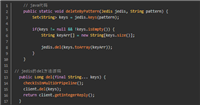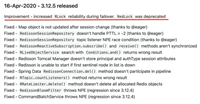在实现社交网络功能中,实现互相关注是必不可少的。在这里,我们将使用redis来实现这个功能,前端使用vue框架实现。
功能要求
我们需要实现以下几个功能:
- 用户能够关注其他用户
- 用户能够取消关注其他用户
- 用户能够查看自己关注的人和被谁关注
- 在用户的主页上,能够显示关注和被关注的数量
redis存储结构设计
我们使用redis的set数据结构来存储用户关注的人和被关注的人。具体来说,每个用户都有一个following和followers属性,分别表示该用户关注的人和被谁关注。然后在redis中使用set类型来存储这些关注信息,在set中,我们将每个关注对象的id存储下来,方便后续的查询。
后端实现
添加关注
我们需要通过api来让用户实现添加关注和取消关注。下面是添加关注的api代码:
// 添加关注
router.post('/followers/:id', async (req, res) => {
try {
const followerid = req.user.id;
const followingid = req.params.id;
// 获取被关注的用户和关注该用户的用户
const following = await user.findbyid(followingid);
const follower = await user.findbyid(followerid);
// 添加关注对象
await redis.sadd(`user:${followerid}:following`, followingid);
await redis.sadd(`user:${followingid}:followers`, followerid);
res.json({ message: `you are now following ${following.username}` });
} catch (error) {
console.error(error.message);
res.status(500).send('server error');
}
});
在这个代码中,我们使用了redis.sadd方法将关注对象的id添加到set中。
取消关注
接下来是取消关注的api代码:
// 取消关注
router.delete('/followers/:id', async (req, res) => {
try {
const followerid = req.user.id;
const followingid = req.params.id;
// 获取被取消关注的用户和取消关注该用户的用户
const following = await user.findbyid(followingid);
const follower = await user.findbyid(followerid);
// 删除关注对象
await redis.srem(`user:${followerid}:following`, followingid);
await redis.srem(`user:${followingid}:followers`, followerid);
res.json({ message: `you have unfollowed ${following.username}` });
} catch (error) {
console.error(error.message);
res.status(500).send('server error');
}
});
这个代码与添加关注的代码类似,只是使用了redis.srem方法来将关注对象的id从set中删除。
查看关注对象
最后,我们需要实现查看关注对象的api。这个api需要分别获取关注和被关注的set,然后将id转换为用户对象。
// 获取关注和粉丝
router.get('/followers', async (req, res) => {
try {
const userid = req.user.id;
// 获取关注和被关注的set
const [following, followers] = await promise.all([
redis.smembers(`user:${userid}:following`),
redis.smembers(`user:${userid}:followers`),
]);
// 将id转换为用户对象
const followingusers = await promise.all(
following.map((id) => user.findbyid(id))
);
const followerusers = await promise.all(
followers.map((id) => user.findbyid(id))
);
res.json({ following: followingusers, followers: followerusers });
} catch (error) {
console.error(error.message);
res.status(500).send('server error');
}
});
前端实现
在前端中,我们使用vue框架来实现。需要提供以下功能:
- 用户可以通过点击按钮来添加和取消关注操作
- 用户的主页可以显示关注和被关注的数量
添加关注和取消关注操作
在vue中,我们可以使用@click监听用户点击事件,并在方法中发送api请求来进行添加和取消关注。下面是代码示例:
<!-- 添加关注 --> <button @click="followuser(user._id)" v-if="!isfollowing(user._id)">关注</button> <!-- 取消关注 --> <button @click="unfollowuser(user._id)" v-else>取消关注</button>
methods: {
// 添加关注
async followuser(id) {
await axios.post(`/api/followers/${id}`);
// 更新关注状态
this.isfollowingusers[id] = true;
},
// 取消关注
async unfollowuser(id) {
await axios.delete(`/api/followers/${id}`);
// 更新关注状态
this.isfollowingusers[id] = false;
},
// 判断是否关注
isfollowing(id) {
return this.isfollowingusers[id];
}
}
在这个代码中,我们使用了isfollowingusers对象来存储所有用户的关注状态。
显示关注和被关注数量
为了在用户的主页上显示关注和被关注的数量,我们需要在后端添加相应的api,并在前端调用数据显示。下面是相关代码:
// 获取关注和粉丝数量
router.get('/followers/count', async (req, res) => {
try {
const userid = req.user.id;
// 获取关注和被关注数量
const [followingcount, followercount] = await promise.all([
redis.scard(`user:${userid}:following`),
redis.scard(`user:${userid}:followers`),
]);
res.json({ followingcount, followercount });
} catch (error) {
console.error(error.message);
res.status(500).send('server error');
}
});
<!-- 显示关注和被关注数量 -->
<div>
<p>关注 {{followingcount}}</p>
<p>被关注 {{followercount}}</p>
</div>
在这个代码中,我们使用了redis.scard方法来获取set的数量。
总结
以上就是使用redis实现互相关注功能的全部内容。通过使用redis的set数据结构来存储关注对象,方便高效地进行添加和取消关注操作。同时,在前端中使用vue框架实现了可交互的关注和取消关注按钮,并在用户主页上显示了关注和被关注的数量。
到此这篇关于redis实现用户关注的项目实践的文章就介绍到这了,更多相关redis 用户关注内容请搜索代码网以前的文章或继续浏览下面的相关文章希望大家以后多多支持代码网!







发表评论